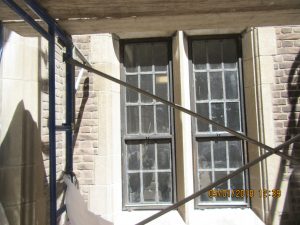The primary function of windows is to provide light, outdoor views, and fresh air to habitable spaces. These connectors of inside and outside environments key components of the building envelope; however, window assemblies in existing buildings are often neglected until major issues such as water infiltration or air leakage occur, and a building envelope inspection is needed.
This oversight is especially common in multi-story residential buildings where window assemblies are typically monitored by unit residents rather than maintenance staff. Due to the cost associated with window replacements for an entire building, building owners tend to either replace windows on a case-by-case basis or perform a major window replacement project around the 40-year anniversary of the existing window assembly.
The unfortunate reality is that most common window assemblies near the end of their life span between 20 and 30 years. Additionally, this time can lessen significantly depending on construction factors and the building façade’s exposure to sun and wind. Once the window assembly begins to deteriorate, a lack of efficiency can quickly lead to increased heating and cooling costs, water infiltration at the seals, UV ray exposure, and extreme swings in interior comfort throughout the day.
depending on construction factors and the building façade’s exposure to sun and wind. Once the window assembly begins to deteriorate, a lack of efficiency can quickly lead to increased heating and cooling costs, water infiltration at the seals, UV ray exposure, and extreme swings in interior comfort throughout the day.
While installing high-efficiency windows at the 20-year mark may seem like an overaggressive approach to building maintenance, advancements in window assemblies associated with window replacement significantly decrease heating and cooling costs.
Window replacement as a building-wide initiative can provide 20% to 30% annual cost savings in energy use for the entire building. Since the passing of Local Law 87 of 2009 increased energy commissioning by requiring select buildings to report energy use consumption, the energy efficiency of buildings and the costs associated with energy consumption is now much more apparent. While every building envelope is not the same, a typical full-scale, high-efficiency window replacement project can pay for itself in energy savings over six to eight years.
Energy-efficient windows lessen condensation, reduce UV exposure, and provide better light, views, and comfort. While window manufacturers and window types have their own unique characteristics, all window assemblies installed in New York State must meet the minimum requirements of the appropriate energy codes enforced by the governing body. The minimum requirements for window energy efficiency in New York City (NYC) are established by the 2016 Energy Conservation Code (2016 NYCECC), which provides the minimum requirements for U-Factor (the rate of heat transfer or how well the window insulates) and Solar Heat Gain Coefficient – SHGC (the fraction of solar heat gain transmitted into the interior of the building and expressed in a number between 0 and 1). The minimum requirements for NYC can be found in Table C402.4 of the 2016 Energy Conservation Code under climate Zone four.

The rule of thumb is the lower the U-Factor, the higher the insulated value of the window assembly, and the lower the SHGC, the more heat energy that’s reflected from the window away from the interior of the building. The northeast has hot and humid summers and cold winters; therefore, most buildings benefit from high U-Factors in window assemblies to handle the vast temperature differentials of these seasons. The SHGC rating, however, is more dependent on the elevation’s orientation which determines the surface wind and sun exposure. However, this strategy will not be as beneficial on some north exposure due to summer sun angles not directly reaching north elevations. Since indirect sun exposure caused by adjacent structures makes it more difficult to determine the SHGC in an urban landscape, it needs to be addressed on a case-by-case basis to ensure optimal efficiency.
In today’s market, there are numerous window assembly replacement options. Since choosing the best window for a project is based on the unique characteristics of the building, it is difficult to generalize what the best window assembly should be; however, the advantages and disadvantages of the most typical window components in the NYC market are as follows:
Frames
- Aluminum/Steel
- Advantages: strong, durable, can be formed to custom shapes and sizes
- Disadvantages: easily conducts heat transfers, can lead to condensation, effectiveness highly depends on the thermal break installation and quality
- Wood/Composites
- Advantages: easier to repair and maintain, better at reducing thermal transfer than aluminum/steel
- Disadvantages: susceptible to rot, limited allowable use in NYC above certain heights and in certain types of construction
- Vinyl
- Advantages: low maintenance, good moisture resistance, low cost
- Disadvantages: swings in expansion and contraction during extreme temperatures, durability to impact, appearance, limited allowable use in NYC above certain heights and in certain types of construction
Glass
- Double Pane
- Advantages: manufacturer standard, best energy efficiency for the money, filled with Argon or Krypton gas to increase insulating value, smaller profile compared to triple pane
- Disadvantages: limited to one layer of insulated gas, the interior glass pane will be limited in thermal reduction and is susceptible to extreme temperatures
- Triple Pane
- Advantages: higher thermal comfort, reduced sound transmission between exterior and interior, ability to resist thermal extremes compared to double-pane glass
- Disadvantages: cost of windows, increased thickness of profile, a slight reduction in light transmission
Insulating Gas
- Argon
- Advantages: less expansive of the two most common insulating gas options, efficient at reducing heat transfer
- Disadvantage: requiring ½” gap between panes to be efficient increases the thickness of window assembly
- Krypton
-
- Advantages: higher insulating value than argon, only ¼” gap between panes reduces the overall thickness of the window assembly
- Disadvantages: most efficient when used in triple-pane window assemblies, significant cost increase over the cost of argon
-
Glass Spacers
- Single Seal
- Advantage: a cost-effective solution for windows that do not have low-conductance gasses
- Disadvantage: not very effective at preventing a thermal break in window assemblies with argon or krypton
- Double Seal
- Advantages: certain configurations allow for a complete thermal break, technology is evolving, and works very well with double and triple-pane window assemblies that contain argon or krypton
- Disadvantages: some assemblies still use aluminum or metal that does not provide a full thermal break between the glass panes, requires skilled labor to properly install, increases the cost of the window assembly
Many combinations of these unique products must be considered in order to generate the appropriate balance of energy efficiency and cost effectiveness for a building. A thorough analysis of the existing building components and an experienced team of building envelope consultants, contractors, and manufacturers can strive to ensure that balance when it’s time for a window replacement project to be performed.